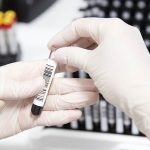Iceland screens, treats, or prevents multiple myeloma (iStopMM) study
The largest scientific study ever conducted in Iceland

All individuals living in Iceland, born in 1975 or earlier, were invited to participate
"The key to a successful screening study is a high participation rate. With the phenomenal support of the population of Iceland, iStopMM will generate knowledge not available anywhere else."
– Sigurður Yngvi Kristinsson, Principal Investigator
Milestones of the iStopMM study
The iStopMM study invites everyone born in 1975 or earlier to take part in one of the most extensive scientific studies ever conducted in Iceland.
In the first month of the study, more than 50,000 Icelanders signed up to participate.

CNN’s Chief Medical Correspondent Dr. Sanjay Gupta and his team traveled to Iceland to explore the country’s innovative medical projects.
Registration for the study ends, with a total of 80,759 registrations, which is equivalent to a 54% participation rate, a unique achievement worldwide.

iStopMM Clinic opens and the first participant starts follow-up in the screening study.

The Promotional Campaign for iStopMM gets an award from The Icelandic Association of Marketers.

Dr. Sigurdur Yngvi Kristinsson, Professor at the University of Iceland and the study’s principal investigator receives the Brian G.M. Durie Outstanding Achievement Award for outstanding research in the field of multiple myeloma.
First participants starts iStopMM treatment trial.

Blood sample collection phase ends with total of 75,422 blood samples being received for screening.
The first scientific article published in the Blood Cancer Journal. In this first paper from the iStopMM trial, the methodology and the recruitment phase of the study was described in detail. The paper introduces the study to the scientific community and shows that the particiation rate is high enabling the study to reach its goals.
First participants in the treatment trial finish treatment.

iStopMM presents four oral abstracts and two posters at the American Society of Hematology (ASH) Annual Meeting in Atlanta.
MGUS has been associated with immune system dysfunction and risk of infection and it has been speculated that individuals with MGUS may have increased risks from COVID-19. This study is the largest study on the issue to date and shows that MGUS does not increase the risk of contracting COVID-19 and dose not affect outcomes in COVID-19. These unexpected results reflect how iStopMM can change how we view multiple myeloma and its precursors.
Many of the planned studies from the iStopMM project use data on chronic disease diagnoses in the Icelandic healthcare registries. In this paper the accuracy of these diagnoses was assessed. The accuracy varied somewhat between diseases but the overall accuracy was estimated at 98.5% which is very high.
An article published in the Journal of Internal Medicine based on iStopMM data shows that the effects of Covid 19 and concomitant societal restrictions did not have a negative impact on population mental health.
An article based on iStopMM data shows that previous reference intervals for serum free light chains (FLC) and the FLC ratio are inaccurate in individuals with kidney disease. The paper proposes new reference intervals for FLC and FLC ratio based on kidney function that changes the definition of light chain MGUS in individuals with kidney disease.
News

Prevalence of multiple myeloma precursors revealed for the first time with iStopMM results
Researchers at iStopMM have for the first time described the prevalence of smoldering multiple myeloma and the findings indicate that it is present in 0.5%

iStopMM study changes the definition of multiple myeloma precursor condition
Recently an interview appeared in Nordic Life Science with Thorir Long author of Defining new reference intervals for serum free light chains in individuals with

Sæmundur Rögnvaldsson MD, PhD
Sæmundur Rögnvaldsson a long-time member of the iStopMM core team defended his doctoral thesis Monoclonal gammopathy of what significance? Overcoming the methodological limitations of studying

iStopMM team member receives IMS Young Investigator Award
We are proud to announce that a PhD student at the University of Iceland and a member of the iStopMM team Jón Þórir Óskarsson was

Major grant from the European Research Council (ERC) for further research on multiple myeloma
Sigurdur Yngvi Kristinsson professor of hematology at the University of Iceland Faculty of Medicine, specialist at Landspitali University Hospital and iStopMM´s principal investigator has been
